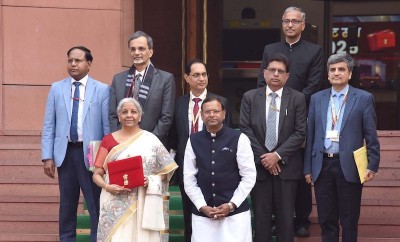
CRR cut to infuse ₹2.5 trillion liquidity, boost investment and credit revival in slowing economy
New Delhi: In a bid to revive domestic demand and energise India’s slowing economy, the Reserve Bank of India (RBI) has not only delivered a sharper-than-expected 50 basis point cut in the repo rate but also announced a 100 basis point reduction in the Cash Reserve Ratio (CRR)—a move that is set to release ₹2.5 trillion into the banking system over the next few months, media reports said.
This is the most significant CRR cut since the pandemic year of 2020 and comes at a time when inflation is showing sustained moderation.
RBI Governor Sanjay Malhotra underscored the shift in policy dynamics by stating at Friday’s post-MPC press briefing, “Inflation is under a lot of control now, and we can accept that we have won the war.”
The central bank now pegs its FY26 inflation forecast at 3.7%, revised down from 4% earlier.
By reducing the CRR from 4% to 3%, the RBI aims to ease liquidity constraints and enable banks to lower lending rates more effectively—thereby stimulating credit flow into the broader economy.
The move is particularly significant as it offers banks added headroom to expand their loan books at a time when credit growth is weakening.
Malhotra emphasised the broader intent, saying, “It is imperative to continue to stimulate domestic private consumption and investment through policy levers to step up the growth momentum.” He added that the advance announcement of the phased CRR reduction—scheduled from September 6 to November 29—was made to provide “certainty to banks and markets regarding the health of the economy.”
The CRR cut is expected to act as a liquidity booster, especially when policy transmission from repo rate cuts to the credit market has been slow.
“The comfortable liquidity surplus in the banking system has further reinforced transmission of policy repo rate cuts to short term rates,” Malhotra said. “However, we are yet to see a perceptible transmission in the credit market segment, though we must keep in mind that it happens with some lag.”
Bond markets welcomed the development, with short-term yields softening and the benchmark 10-year G-sec yield touching an intraday low of 6.290%, before settling at 6.289%.
Equity markets also reacted positively, as the Sensex closed 0.92% higher at 82,188.99 and the Nifty surged past the 25,000 mark.
The CRR cut is particularly timely given concerns around sluggish GDP momentum and weak credit offtake.
While the RBI retained its FY26 GDP growth forecast at 6.5%, it acknowledged external risks from trade disruptions, geopolitical tensions, and weather uncertainties. With inflation under control, the central bank appears to be prioritising growth.
According to the Monetary Policy Committee (MPC), the liquidity injection from the CRR cut will complement the repo rate reduction in speeding up the monetary transmission.
However, economists point out that some of the liquidity gains may be neutralised by RBI’s ongoing unwinding of its forward dollar book, which led to a ₹2.3 trillion liquidity drain between February and April this year.
Still, by combining repo rate cuts with a sizable CRR reduction, the RBI has sent a strong signal that it is ready to deploy all available tools to support economic recovery.
“This changed growth-inflation dynamics calls for not only continuing with the policy easing but also frontloading the rate cuts to support growth,” Malhotra said.
Support Our Journalism
We cannot do without you.. your contribution supports unbiased journalism
IBNS is not driven by any ism- not wokeism, not racism, not skewed secularism, not hyper right-wing or left liberal ideals, nor by any hardline religious beliefs or hyper nationalism. We want to serve you good old objective news, as they are. We do not judge or preach. We let people decide for themselves. We only try to present factual and well-sourced news.







